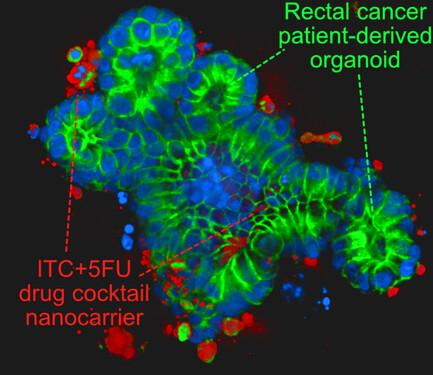High-Load Core@Shell Nanocarriers with Irinotecan and 5-Fluorouracil for Combination Chemotherapy in Colorectal Cancer
IF 11.1
Q1 MATERIALS SCIENCE, MULTIDISCIPLINARY
引用次数: 0
Abstract
Colorectal cancer (CRC) is the third most common cancer type and second leading cause of cancer-related deaths worldwide, requiring novel drug-delivery concepts. ITC@ZrO(TocP)/ZrO(FdUMP) core@shell nanocarriers (designated ITC-FdUMP-NC) with the clinically relevant chemotherapeutics irinotecan (ITC) and fluoro-2′-deoxyuridine-5′-phosphate (FdUMP) (active derivative of 5′-fluorouracil/5-FU) are a new type of nanocarrier with high drug payload (22 wt% of lipophilic ITC: particle core; 10 wt% of hydrophilic FdUMP: particle shell). The nanocarriers are tested in different CRC cell lines, a normal cell line, and rectal cancer patient-derived organoids (PDOs). Fluorescence-labeled nanocarriers show efficient uptake by all CRC cells and allow to distinctly track the intracellular trafficking toward endolysosomal compartments. Although free chemotherapeutic drugs exhibit a greater potency in 2D cell cultures, ITC-FdUMP-NC demonstrate equivalent cytotoxic efficacies as the freely dissolved drugs in the more complex 3D rectal cancer PDOs. The sustained drug-release profile of the nanocarriers contrasts favorably with conventional free drugs, potentially enhancing the therapeutic outcome in vivo. With a chemotherapeutic cocktail comparable to the clinically applied FOLFIRI (ITC + 5-FU), the ITC-FdUMP-NC represent a novel type of nanocarrier with high anti-tumor effect and high drug payload, offering a promising strategy to circumvent chemoresistance and to improve therapy efficacy in vivo with less side effects.

含有伊立替康和 5-氟尿嘧啶的高负载核@壳纳米载体用于结直肠癌的联合化疗
结肠直肠癌(CRC)是全球第三大常见癌症类型,也是癌症相关死亡的第二大原因,因此需要新颖的给药概念。ITC@ZrO(TocP)/ZrO(FdUMP)核@壳纳米载体(命名为ITC-FdUMP-NC)含有临床相关化疗药物伊立替康(ITC)和氟-2′-脱氧尿苷-5′-磷酸(FdUMP-NC)。deoxyuridine-5′-phosphate (FdUMP)(5′-氟尿嘧啶/5-FU 的活性衍生物)的新型纳米载体,具有高载药量(22 wt% 的亲脂性 ITC:亲水性 FdUMP:颗粒外壳)。纳米载体在不同的 CRC 细胞系、正常细胞系和直肠癌患者衍生的器官组织(PDOs)中进行了测试。荧光标记的纳米载体被所有的 CRC 细胞有效吸收,并能清楚地追踪细胞内向溶酶体内腔的迁移。虽然游离化疗药物在二维细胞培养物中表现出更强的效力,但在更复杂的三维直肠癌 PDO 中,ITC-FdUMP-NC 表现出与自由溶解药物相当的细胞毒性效力。纳米载体的持续药物释放特性与传统的游离药物形成鲜明对比,有可能提高体内的治疗效果。ITC-FdUMP-NC的化疗鸡尾酒与临床应用的FOLFIRI(ITC + 5-FU)相当,它代表了一种新型纳米载体,具有高抗肿瘤效果和高载药量,为规避化疗耐药性、提高体内疗效并减少副作用提供了一种前景广阔的策略。
本文章由计算机程序翻译,如有差异,请以英文原文为准。
求助全文
约1分钟内获得全文
求助全文
来源期刊
CiteScore
14.00
自引率
2.40%
发文量
0
期刊介绍:
Small Science is a premium multidisciplinary open access journal dedicated to publishing impactful research from all areas of nanoscience and nanotechnology. It features interdisciplinary original research and focused review articles on relevant topics. The journal covers design, characterization, mechanism, technology, and application of micro-/nanoscale structures and systems in various fields including physics, chemistry, materials science, engineering, environmental science, life science, biology, and medicine. It welcomes innovative interdisciplinary research and its readership includes professionals from academia and industry in fields such as chemistry, physics, materials science, biology, engineering, and environmental and analytical science. Small Science is indexed and abstracted in CAS, DOAJ, Clarivate Analytics, ProQuest Central, Publicly Available Content Database, Science Database, SCOPUS, and Web of Science.

 求助内容:
求助内容: 应助结果提醒方式:
应助结果提醒方式:


